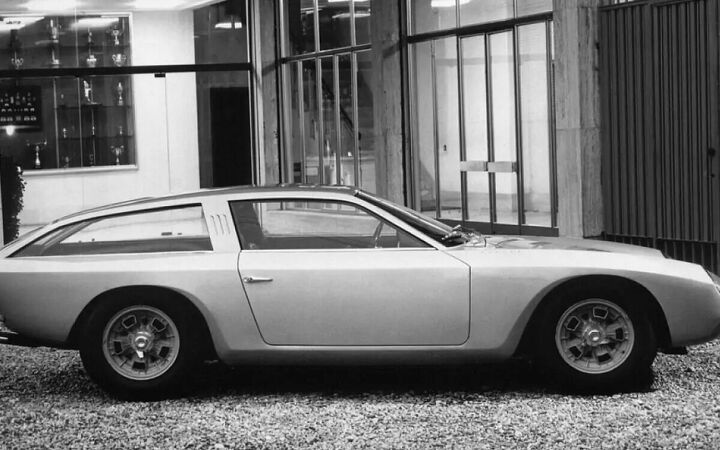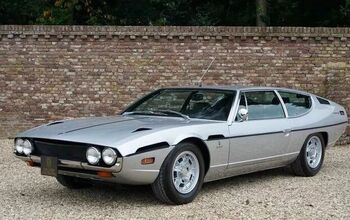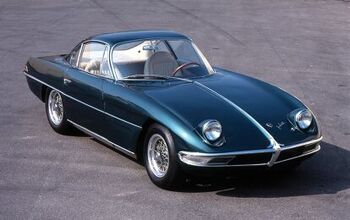Rare Rides Icons: Lamborghini's Front-Engine Grand Touring Coupes (Part V)

Lamborghini proved it could make a luxurious grand touring coupe that a few people were willing to buy instead of a Ferrari with its first-ever production car, the 350GT. Based on the 350GTV prototype that was not actually drivable, the 350GT eventually grew and matured into the very similar 400GT we featured last time.
At its inception, the 400GT was just a 350GT with a larger engine, since the intended roof edits to turn the 2+1 into a 2+2 were not production ready. Lamborghini advertised the 350, 400, and 400 2+2 as three separate models, a fun take on the truth. But after three variations of the original 350 design, it was time for something new. The replacement process was not without drama.
While the 400GT was in the latter part of its short production, Ferruccio sought a replacement. The new car would exist in the same front-engine V12 market segment as its predecessor, and act as a sane counterbalance to the mid-engine Miura. Lamborghini thought Carrozzeria Touring should get the design work since they did such a nice job turning the 350GTZ static display into a working automobile. Touring’s patented Superleggera construction method was important to Lamborghini, as it slimmed down the performance coupe’s arch-enemy: Curb weight.
Lamborghini reached out to Touring for a new design in 1966. Touring was only too happy to oblige, as the company was in dire straits from a financial perspective. To save time and development costs, their new concept was based on the company’s current 400GT, which Touring simply stripped of its body.
Lamborghini asked for something new, and Touring took that directive very seriously. So seriously in fact that they ditched the coupe body style in favor of a rakish shooting brake. The body’s shape had sharp creases and was angular in the early Seventies sort of way. Visual weight was at the middle and rear of the new car, as a shorter hood put the engine further back in the chassis.
The mostly smooth hood was narrowed by creased fenders, which had a strong leading edge and an additional character line that led to a sort of melted trapezoid-covered headlamp. Underneath was a smiling, empty grille decorated only by a thin chrome strip of the bumper.
The side of the new shooting brake sported only a few details, like gills along the fender near the fast A-pillar, and body molding around the wheel arch that formed the lower rocker panel. A thick B-pillar just after the door was also decorated with gills and visually separated the passenger space from the large cargo area.
From there the roof sloped downward and met with the side character line to form the lower edge of the hatchback. The hatch itself had two visible hinges on the roof and was narrow overall as it did not include the rear clip that held the brake lamps and bumper.
The hatch and rear clip were largely without decoration, as a pair of simple rectangular (almost British-looking) horizontal lamps provided the required lighting. A thin, sweeping bumper mirrored the one at the front and hung above four quite large exhaust outlets.
The concept’s interior was a departure from the production 400GT. It simplified the gauges into two large dials in front of the driver and moved switches in a pod near the shift lever for easy reach. The 400GT’s switches were arranged in a center stack that was almost flush with the dash.
Aside from the daring body and interior, the Touring design remained 400GT underneath. It shared the 2+2’s engine, transmission, suspension, and braking. The wheelbase was an identical 100.4 inches as well. The shooting brake shrank the passenger area and the hood over the 400GT, and ended up almost four inches shorter, at 172.4″.
It was also slightly narrower at 67.7 inches over 68″ in the 400GT. With its faster profile it was also lower to the ground, and at 47.2 inches was more than two inches shorter than the 400. The changes to body format made for less weight too, as the 3,245 pounds of the 400 were reduced to just 2,866 in the Touring concept. Worth noting that it was a fully working vehicle.
The other reason the new Touring was lighter was its passenger capacity. Even though the ask was for a new grand touring coupe, the hatchback gave up a 2+2 configuration and was a two-seater. Touring gave their new concept a name with history: Flying Star II. It was a throwback to the roadsters the company designed in the Thirties, which were all penned by Giuseppe Seregni, and applied to bare chassis from Alfa Romeo and Isotta Fraschini.
Perhaps the designers at Touring were inspired by the daring Bertone-designed Miura and wanted to give Lamborghini another exciting design for its lineup. But it wasn’t what Ferruccio was looking for in his 400GT replacement and the design was rejected outright, and immediately. It became the final design from Touring, as the company that penned the Alfa Romeo 2600, and the DB4, DB5, and DB6 for Aston Martin went bankrupt the very same year. The brand lie dormant from 1966 until it was resurrected in 2006, and remains active today.
Since the first 400GT replacement was a no-go, Lamborghini took a look at a design from Neri & Bonacini. The coachbuilder built the 350GTV prototype and later constructed the tube frames for the 350GT to which the Touring body panels were applied. As they were so familiar with the 350GT’s chassis, they selected it as the basis for their own design take.
This one-off was referenced at the end of our last entry, and it has a somewhat muddy history. While one source says the car was a commission for an American client who wanted to race it at the 24 Hours of Le Mans, another says it was Lamborghini who asked for the design as a potential replacement for the 400GT. In either case, the small firm spent a lot of time in the design of the two-seater and built its all-aluminum body by hand in their coachworks.
The Neri & Bonacini design was very different from the 400GT and went for a Ferrari-like approach. Sweeping fenders highlighted an elongated hood, which ended in a narrow wedge-shaped front end with large recessed circular headlamps. The only bumper was a chrome strake on either corner.
A two-seater, the coupe had a much softer character line than the Touring design and focused on classic organic curves that were planted securely in the mid-Sixties. The B-pillar was angled forward and covered the starting point of the C-pillar, which had a flying buttress on either side. Notable for its intended purpose, there was an integral roll bar within the thick C-pillar. Between the buttresses was a large back window that allowed a generous parcel shelf.
A consequence of the rear pillar’s design was the small trunk lid, which was only as wide as the rear window. The rounded fenders and curvy buttresses met at a near-vertical rear end that was framed by a strong crease around its perimeter. Bumpers were again in two pieces and wrapped sharply around the rear fender toward the back tire.
Though it was on the 350GT’s chassis, the build took place in 1966 and the 3.9-liter V8 from the 400 was available. The larger engine was used to give the racer design the best performance possible. Neri & Bonacini initially called their car the 400GT Neri & Bonacini, but since that didn’t exactly roll off the tongue it was renamed to 400GT Monza.
The American customer who wanted to race the Monza at Le Mans never took delivery of the car: Apparently, there were problems with its race homologation. After it lost its benefactor, the car was shown at the 1967 Barcelona Motor Show. Perhaps it was around this time that Neri & Bonacini offered the design to Lamborghini as an afterthought, rather than via direct request from Ferruccio himself.
In any event, Lamborghini didn’t like the Monza and the design was rejected. And much like Touring, their Lamborghini take would be one of the firm’s last. Without much work or contracting (Lamborghini moved on to another frame supplier by the 400GT), the company founders went their own directions. In 1967 Bonacini left to work for De Tomaso, and Neri opened a small shop called Motors-World-Machines.
After two rejected designs, Lamborghini felt it would be more productive to bring in a designer from outside and have them work directly with in-house staff on a group project. It was a project that would be revised and massaged into a version 2.0, and that became the Islero. We’ll pick up there next time.
[Images: Lamborghini, YouTube]

Interested in lots of cars and their various historical contexts. Started writing articles for TTAC in late 2016, when my first posts were QOTDs. From there I started a few new series like Rare Rides, Buy/Drive/Burn, Abandoned History, and most recently Rare Rides Icons. Operating from a home base in Cincinnati, Ohio, a relative auto journalist dead zone. Many of my articles are prompted by something I'll see on social media that sparks my interest and causes me to research. Finding articles and information from the early days of the internet and beyond that covers the little details lost to time: trim packages, color and wheel choices, interior fabrics. Beyond those, I'm fascinated by automotive industry experiments, both failures and successes. Lately I've taken an interest in AI, and generating "what if" type images for car models long dead. Reincarnating a modern Toyota Paseo, Lincoln Mark IX, or Isuzu Trooper through a text prompt is fun. Fun to post them on Twitter too, and watch people overreact. To that end, the social media I use most is Twitter, @CoreyLewis86. I also contribute pieces for Forbes Wheels and Forbes Home.
More by Corey Lewis
Latest Car Reviews
Read moreLatest Product Reviews
Read moreRecent Comments
- Carfan94 Never, it doesn’t get cold eneough here in TN, to switch to winter tires. But it gets cold enough that running Summer tires year round is impractical. I’m happy with my All seasons
- Analoggrotto Anyone who has spent more than 15 minutes around a mustang owner would know this will be in insta-hit.
- Akear If this is true then they won't go out of business. Good for them!
- FreedMike Interesting time capsule.
- 6-speed Pomodoro I had summer and winter tires for a car years ago. What a pain in the butt. You've permanently got a stack of tires hogging space in the garage and you've got to swap them yourself twice a year, because you can't fit a spare set of tires in a sportscar to pay someone else to swap 'em.I'd rather just put DWS06's on everything. But I haven't had a sportscar in 8 years, so maybe that's a terrible idea.







































Comments
Join the conversation
Maybe Toyota borrowed the Touring profile for the 1980 Celica Supra: https://images.thetruthaboutcars.com/2009/12/CC-8-001-800-550x299.jpg
400GT Monza has flying buttresses, like Notre-Dame. Which leads to the obvious question: If I acquire the 400GT Monza and happen to set the roof on fire during repair work, will the whole world chip in to fix it?